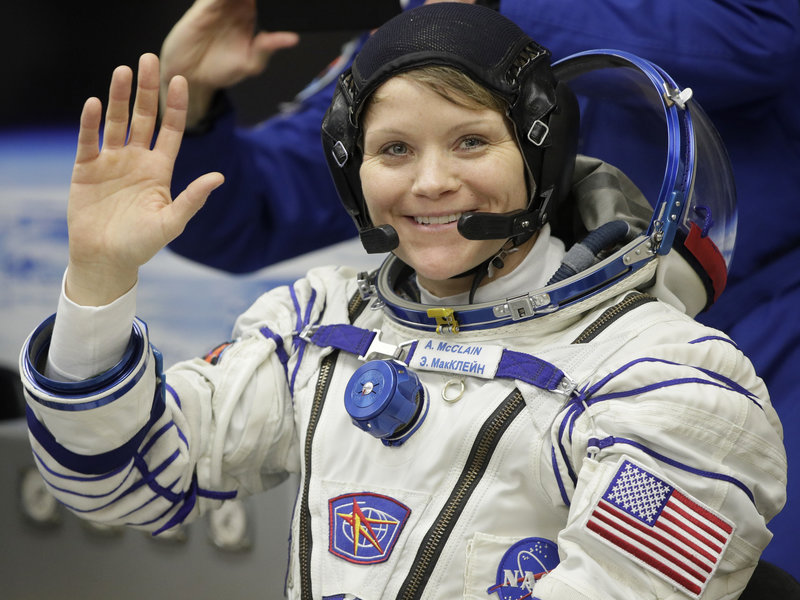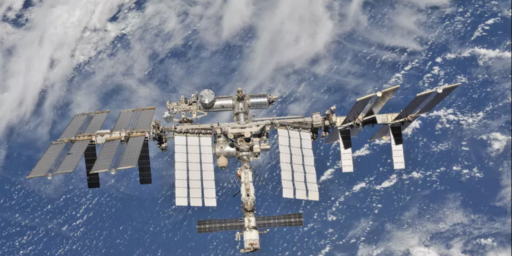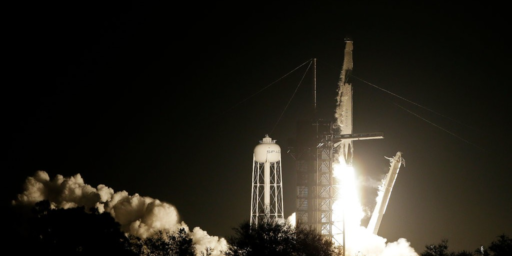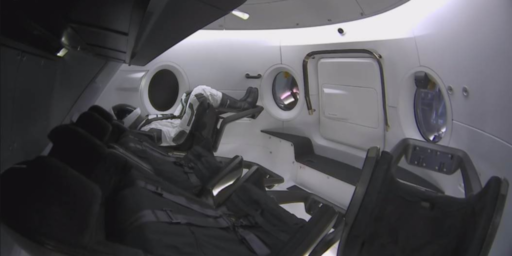Spacesuits Don’t Come in Size ‘Small’
History's first all-female spacewalk was thwarted by a lack of smaller suits.

NPR (“NASA Scraps First All-Female Spacewalk For Want Of A Medium-Sized Spacesuit“):
History was supposed to be made Friday when, for the first time ever, two female astronauts were scheduled to do a spacewalk together outside the International Space Station. However, one of the astronauts was switched out this week because of a lack of “spacesuit availability.”
Last week, NASA astronaut Anne McClain wore a large-sized spacesuit to conduct her first-ever spacewalk, where she helped swap out aging batteries that store energy collected by the station’s solar panels. While she was working, she realized that her suit was too big to maneuver in comfortably. Instead of the large, she would need a medium-sized hard upper torso – what NASA calls “the shirt of the spacesuit.”
Two mediums existed on the ISS, but only one was prepped for a spacewalk. Instead of devoting extensive crew time to make the extra medium-sized suit space-worthy by Friday, NASA decided to restaff: Astronaut Nick Hague will go in McClain’s place, and do the walk with astronaut Christina Koch.
“When you have the option of just switching the people, the mission becomes more important than a cool milestone,” NASA spokeswoman Stephanie Schierholz told the New York Times.
Well, sure. But it’s not like the composition of the crew was unknown. Why not stock suits to fit the astronauts assigned to the mission?
Preparing a spacesuit for exposure to the vacuum of space is no easy task. Last week McClain posted a video of her doing a “loop scrub” on a suit, necessary to keep the cooling system running properly. Astronauts also conduct several fit checks as they prepare for spacewalks, according to Space.com, as astronauts grow taller in the microgravity of space. In fact, McClain said on Twitter earlier this month that she had already grown 2 inches in the few months she’s been on the ISS.
Well, okay. But that makes the problem even harder to understand. McClain now needs a larger suit than she did at launch; yet the issue is the suits aren’t small enough. Were they figuring she would grow into it?
McClain and Koch were both part of NASA’s 2013 astronaut candidate class, in which eight potential astronauts were chosen from more than 6,100 applicants. The class had an equal split between women and men.
The availability of enough spacesuit sizes has long been a bit of a sensitive subject for NASA. As NPR’s Nell Greenfieldboyce reported in 2006, opportunities for women may have been hampered by the fact that spacesuits only came in medium, large, and extra-large sizes. They used to come in small, but that size was cut in the 1990s when NASA had to redesign the suits because of a technical glitch.
That meant anyone who was on the smaller side wouldn’t be able to make a spacewalk, astronaut Mike Fincke told Greenfieldboyce. And when the agency looked into the issue in 2003, it found that about a third of its female astronauts couldn’t fit into existing suits. But Lara Kearney, who worked on the small suit, said it’s not about gender, but rather about logistics and cost-effectiveness. “Do we spend around $15 million to accommodate, relatively speaking, a few more people than we could today? Or, do we take that money, and turn it towards the suit development for the next generation?”
NASA has no current plans for an all-female spacewalk, but given that 12 of the agency’s 38 active astronauts are women, Schierholz told the Times she thinks it’s only a matter of time. “We’re sort of getting to the point of inevitability.”
Indeed. I don’t pretend to understand the technical and logistical challenges of making spacesuits. I can accept the notion that it’s too expensive to create a small suit because it would require further miniaturization or a new template that would hardly get used simply doesn’t make sense given economies of scale. But it’s bizarre, indeed, that we can make medium suits but can’t afford enough of them to meet crew demand. Then again, we’re eighteen years into the war in Afghanistan and still don’t have body armor that fits the female torso.






“McClain now needs a larger suit than she did at launch”
She was using a large. Now she finds a medium fits her better. It’s contrary I know but that’s what the story says.
Here’s the real problem: the current space suit design dates from 1978 and there are only 11 of them total in use. NASA is too strapped for cash to go through the expensive process of designing and building a new one (the Russian Orlan suit also dates from the 70s). There’s supposed to be one next decade, maybe, but who knows. So this isn’t a question of sexism or lack of planning, just the logistics.
And, as noted in the article, the problem has come about because NASA has been doing something good: trying to up the percentage of their astronaut corps who are women. So you can think about it as having 1970s suits being put on 2010s astronauts.
@Hal_10000:
It says she tried a large last time and it was too big. You’d think they’d have figured out what size she needed before shooting her into outer space.
Yes, good perspective. It’s really weird to me. The space program is really expensive given how small it is. I’m shocked that there are only 38 total astronauts.
@James Joyner:
It was vastly more expensive in the Apollo era. There were two years in the 60’s where NASA comprised over 4% of the federal budget. 7 years it was over 2% of the federal budget. For the last few decades it’s been about one half of 1% of the federal budget
@Teve:
Oh, sure. We were on a mission started by a martyred President to put on man on the moon by the end of the decade–and barely made it. Unfortunately, the romantic and nationalistic appeal of the Moon Shot era is long past us and NASA’s mission has become anodyne.
@James Joyner: Oh I know, I just think we get a hell of a lot for that 20 billion or so that NASA gets per year. NASA’s entire budget is less than the additional amount that Trump threw the Pentagon last year for no clear reason.
I’m in the minority among the geeks in that I think that human spaceflight is largely romantic bullshit, I don’t support human missions to the Moon, I don’t support human missions to Mars, I think that money could be spent more efficiently, but money spent on any of those things is still better than turning out more tanks that go straight into long-term storage, or hundred-million-dollar jets that can’t fly in the rain.
@Teve:
I wouldn’t go that far, but they are vastly more expensive.
On the other hand, once they get going, they achieve results quickly. I mean, sure, you could have sent probes to dig around the Moon and bring back samples. But that would have taken decades.
On the gripping hand, if you absolutely had to have humans along every time, no way we’d have had probes fly by, and orbit, Saturn, Jupiter, and Venus, much less fly-bys of Uranus, Neptune and Pluto, or any asteroids or comets.
We’re going to need something like a space elevator, or incredibly simple and cheap, and safe, fusion reactors, if we are to develop a real space travel industry. Chemical rockets will simply never be cheap enough for mass travel. We can launch probes anywhere, literally, with existing hardware. We can’t launch people farther than the Moon, unless they were willing to die out there. And I don’t mena die decades from now, I mean within a few years when the expendables (food, air, water) run out.
All the comments here have been reasonable, but at times I feel that I’ve been the only one to have worked in a large bureaucracy, where a hundred small decisions add up to a perplexing outcome. To understand the present requires an archaeologist who can scrape away the layers of accumulated dirt, or perhaps an oral historian who can tease out what actually happened and why. In my (admittedly) limited experience, there is never any malicious intention, merely a desire to face the pressing issues at hand. And one fine day, the whole system seems woefully out of date. The law is a good example, in particular around the issues of digital privacy where judges simple can longer make much sense of the present using the wisdom of the past. NASA now finds itself with limited space suits that are insufficient to meet today’s requirements. Not stupidity. Not sexism. Just firefighting with a limited budget and an imperfect vision of the future.
@Teve:
Hate to be a guy who will give Trump credit for any kind of foresight, but maybe his reptilian brain stem somehow realized that the extra Pentagon money was going to be where his “wall” funds would come from.
@Just nutha ignint cracker:
Wait, wait, wait.
Are you saying the Pentagon is in Mexico?
I don’t recall us ever owning Virginia…
CC the Democratic party.